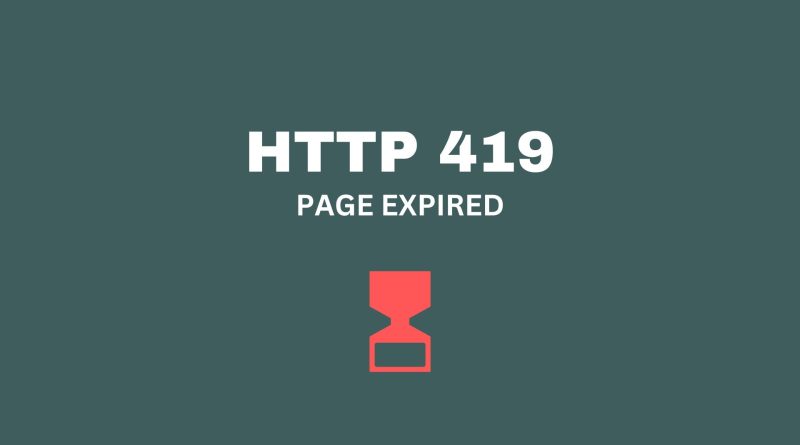HTTP 419 (Page Expired): What is it and how to fix it
Have you ever been working on a web page and refreshed it only to find an HTTP 419 error code? If so, you’re not alone – this common problem can affect websites that rely heavily on server-side scripting languages like PHP. But what does the Error Code Status for ‘HTTP 419 (Page Expired)’ actually mean and how do you go about fixing it? In this post, we’ll cover everything from explaining how the error is caused to offering up solutions.t
What are the http status codes
HTTP status codes are three-digit numbers that are returned by a web server in response to a client’s request using Hypertext Transfer Protocol (HTTP). These codes indicate the status of the request and whether it was successful or not. Some common status codes include 200 OK, 404 Not Found, and 500 Internal Server Error.
These codes can be separated into five classes, with the initial digit in each http status code showing which class it falls into. Here is an overview of these categories:
- 1xx: Informational – These codes verify that your request has been acknowledged and is currently being processed.
- 2xx: Successful – An indication of success, these codes signify that the requested resource is being sent back to you. You can rest assured knowing that your request has been fulfilled!
- 3xx: Redirection – To complete the request, clients must adhere to these codes that signify further steps of action.
- 4xx: Client Error – These codes demonstrate that the client’s inquiry contained a mistake, such as an excluded or incorrect parameter.
- 5xx: Server Error – These codes signalize that the server encountered an issue and couldn’t process the initial request.
What is the 419 Page Expired error code
The 419 Page Expired error code is a 4xx status code, specifically in the 419 range. It indicates that request failed and the server was unable to process the request because the session has expired. This can happen if the user has been inactive for too long or if their session has been terminated on the server side. This error typically occurs when a user attempts to make a request using any http method such POST request (a request method used to submit data to a server) using an outdated or invalid token.
The 419 Page Expired error code is not an official HTTP status code defined in the HTTP/1.1 specification. It is not officially recognized by the Internet Assigned Numbers Authority (IANA) as a standard HTTP status code. This error response code is specific to certain web applications, frameworks, or libraries, and its use and meaning may vary depending on the implementation.
It’s worth noting that, although the HTTP status codes are standardized, web developers and framework authors may choose to use non-standard codes for specific purposes. For example, some developers may use the 419 status code to indicate a session timeout or expired CSRF token, while others may use different codes or custom error messages to convey the same information. Therefore, it’s important to check the documentation of the specific web application or framework to understand the meaning and handling of the 419 Page Expired error code.
Causes of 419 Page Expired error code (list explained in details)
There are several causes of the 419 Page Expired error code:
- Session Timeout: If a user has been inactive for too long, their session may expire on the server. This can cause the 419 error when the user attempts to perform an action that requires a valid session.
- Server-side Session Termination: The server may terminate a session for various reasons, such as security or maintenance. This can also cause the 419 error when the user attempts to perform an action that requires a valid session.
- CSRF Token Invalidation: Some websites use CSRF tokens to protect against cross-site request forgery. These tokens can expire, and if a user attempts to perform an action with an expired token, the server will return a 419 error due to a csrf token verification failure.
- Incorrect URL: Some websites use URLs that include session information, such as a session ID. If a user attempts to access a page with an incorrect or outdated URL, they may receive a 419 error.
How to fix 419 Page Expired error code (explain in details)
- Refresh the page: If the error is caused by a session timeout, simply refreshing the page may re-establish the session and allow the user to continue.
- Log in again: If the error is caused by a server-side session termination, the user may need to log in again to re-establish their session.
- Check the URL: If the error is caused by an incorrect URL, the user should check the URL and ensure it is correct.
- Report the error to the website administrator: If the error persists, the user can report it to the website administrator for further investigation.
Similar http statuses to 419 Page Expired
There are several similar HTTP status codes to the 419 Page Expired error code that indicate a similar issue of session expiration or authentication failure:
401 Unauthorized: This status code indicates that the user is not authenticated and must provide valid credentials before being granted access to the requested resource.
403 Forbidden: This status code indicates that the user is authenticated but lacks the necessary permissions to access the requested resource.
407 Proxy Authentication Required: This status code indicates that the user must authenticate with a proxy before being granted access to the requested resource.
440 Login Timeout: This is a non-standard status code, but it’s similar to a 419 error, it indicates that the user’s session has expired and the user needs to re-login again.
494 Request Header Too Large: This is a non-standard status code, it’s similar to a 419 error, it indicates that the request header contains too much information and the server can’t process it.
All HTTP status codes by categories
Informational responses
(100 – 199)



